#sustainable agricultural
Explore tagged Tumblr posts
Text
Bringing Renewable Energy to Local Farmers.

Eco-innovative farming solutions are vital to ensuring the global reduction of greenhouse gas (GHG) emissions related to agriculture. Biodôme du Maroc, a small, fast-growing Moroccan company, provides local farmers with a technology that gives them access to renewable energy for on-farm use. Founded in 2013 by Dr. Fatima Zahra Beraich, Biodôme du Maroc is the first Moroccan company to specialize in the recovery of organic waste through natural treatment and environmentally friendly processes. This is to enable farmers in rural areas to produce biogas and fertilizer.

For the environment, biogas helps to reduce greenhouse gas emissions from abandoned organic waste and minimizes the risk of polluting waterways. This “clean” method of energy production also reduces reliance on wood as a fuel source. Biodôme du Maroc offers a range of small-scale agricultural anaerobic digesters. These digesters use a simple and innovative system to produce biogas and recover organic matter. Inside underground concrete enclosures, farmers can deposit different kinds of organic waste, such as household, plant and animal waste, which is fermented in a biological accelerator. In this process, gas is produced through methanization or anaerobic bio-digestion, where bacteria naturally break down organic matter within weeks.

By providing a technology that produces gas from organic waste, Biodôme du Maroc gives local farmers access to renewable energy for agricultural production.
Dr. Beraich currently holds six patents covering innovations that improve the efficiency and performance of Biodômeʼs bio-digesters. “The process of securing a patent means that our technology is evaluated by experts and allows us to understand just how different our inventions are from other competing technologies. This allows us to protect the inventive characteristics of our outputs,” explains Dr. Beraich. “With these patents in hand, we hope to be able to license our more recent patented innovations.” The support of the Moroccan Association for Research and Development (R&D Maroc) – part of the network of Technology and Innovation Support Centers (TISCs) in Morocco – has played a critical role in the success of Biodôme du Maroc. “I learned about the TISC network at an outreach event at the University organized by the Moroccan Industrial and Commercial Property Office,” Dr. Beraich explains. R&D Maroc helped Dr. Beraich secure seed funding and also ensured she had the help she needed to draft her patent applications, and license and access the technology she required to create and commercialize her bio-digesters. Biodôme is currently marketing its patent-protected bio-digesters in Morocco and across Africa.

#Eco-innovative farming solutions#worldipday#26 april#sdgs 12#sdg13#sdg11#sdg6#sdg7#ip and the sdgs#ip at work#sustainable agricultural#competing technologies#invention#patented technologies#patented innovation#Technology & Innovation#Innovation#r&d#Moroccan Industrial and Commercial Property Office#morrocco#bio-digesters#patent application#patent-protected
0 notes
Text
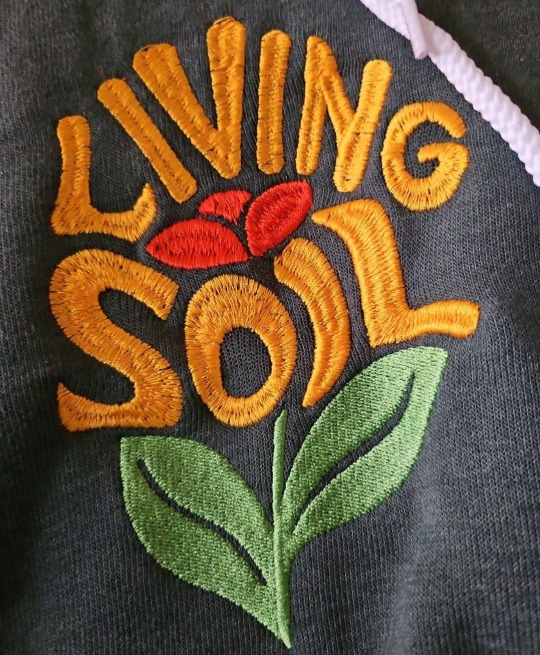

🌱✨️ "Living Soil" Embroidered Crewnecks & Hoodies ✨️🌱
Stay cozy while supporting soil health and sustainable farming 💚💛❤️
🌟 when you sign up for email offers and updates on our website, you get a chance to win up to 50% OFF your order!
🌟 FREE SHIPPING for orders over $50!!!
#soil health#soil science#soil#permaculture#environmental education#enviroment art#regenerative agriculture#regenerative farming#agriculture#sustainable living#sustainable farming#sustainability#organic life#organic matter#organic lifestyle#organic farming#organic#compost lifestyle#composting#compost#vermicompost#biodiversity#ecomindset#conservation#microbes#plant life#plant lover#street style#hippie#stoner society
536 notes
·
View notes
Text
"Despite the Central Appalachia ecosystem being historically famous as coal country, under this diverse broadleaf canopy lies a rich, biodiverse world of native plants helping to fill North America’s medicinal herb cabinet.
And it turns out that the very communities once reliant on the coalfields are now bringing this botanical diversity to the country.
���Many different Appalachian people, stretching from pre-colonization to today, have tended, harvested, sold, and used a vast number of forest botanicals like American ginseng, ramps, black cohosh, and goldenseal,” said Shannon Bell, Virginia Tech professor in the Dept. of Sociology. “These plants have long been integral to many Appalachians’ livelihoods and traditions.”
50% of the medicinal herbs, roots, and barks in the North American herbal supply chain are native to the Appalachian Mountains, and the bulk of these species are harvested or grown in Central Appalachia, which includes southern West Virginia, eastern Kentucky, far-southwest Virginia, and east Tennessee.
The United Plant Savers, a nonprofit with a focus on native medicinal plants and their habitats, has identified many of the most popular forest medicinals as species of concern due to their declining populations.
Along with the herbal supply chain being largely native to Appalachia, the herb gatherers themselves are also native [to Appalachia, not Native American specifically], but because processing into medicine and seasonings takes place outside the region, the majority of the profits from the industry do too.
In a press release on Bell’s superb research and advocacy work within Appalachia’s botanical communities, she refers back to the moment that her interest in the industry and the region sprouted; when like many of us, she was out in a nearby woods waiting out the pandemic.
“My family and I spent a lot of time in the woods behind our house during quarantine,” Bell said. “We observed the emergence of all the spring ephemerals in the forest understory – hepatica, spring beauty, bloodroot, trillium, mayapple. I came to appreciate the importance of the region’s botanical biodiversity more than ever, and realized I wanted to incorporate this new part of my life into my research.”
With co-investigator, John Munsell at VA Tech’s College of Natural Resources and Environment, Bell’s project sought to identify ways that Central Appalachian communities could retain more of the profits from the herbal industry while simultaneously ensuring that populations of at-risk forest botanicals not only survive, but thrive and expand in the region.
Bell conducted participant observation and interviews with wild harvesters and is currently working on a mail survey with local herb buyers. She also piloted a ginseng seed distribution program, and helped a wild harvester write a grant proposal to start a forest farm.
“Economic development in post-coal communities often focuses on other types of energy development, like fracking and natural gas pipelines, or on building prisons and landfills. Central Appalachia is one of the most biodiverse places on the planet. I think that placing a greater value on this biodiversity is key to promoting a more sustainable future for the region,” Bell told VA Tech press.
Armed with a planning grant of nearly half a million dollars, Bell and collaborators are specifically targeting forest farming as a way to achieve that sustainable future.
Finally, enlisting support from the nonprofit organization Appalachian Sustainable Development, Virginia Tech, the City of Norton, a sculpture artist team, and various forest botanicals practitioners in her rolodex, Bell organized the creation of a ‘living monument’ along Flag Rock Recreation Area in Norton, Virginia.
An interpretive trail, the monument tells the story of the historic uses that these wild botanicals had for the various societies that have inhabited Appalachia, and the contemporary value they still hold for people today."
-via Good News Network, September 12, 2024
#appalachia#united states#biodiversity#herbs#herbal medicine#herbalism#native plants#conservation#sustainability#sustainable agriculture#solarpunk#good news#hope
713 notes
·
View notes
Text
RPTU University of Kaiserslautern-Landau has shown for the first time, in a joint study with BOKU University, that permaculture brings about a significant improvement in biodiversity, soil quality and carbon storage. In view of the challenges of climate change and species extinction, this type of agriculture proved to be a real alternative to conventional cultivation—and reconcile environmental protection and high yields. Permaculture uses natural cycles and ecosystems as blueprint. Food is produced in an agricultural ecosystem that is as self-regulating, natural and diverse as possible. For example, livestock farming is integrated into the cultivation of crops or the diversity of beneficial organisms is promoted in order to avoid the use of mineral fertilizers or pesticides. In a study, published in the journal Communications Earth & Environment, researchers from RPTU and BOKU have now, for the first time, comprehensively investigated the effects of this planning and management concept on the environment.
[...]
"Permaculture appears to be a much more ecologically sustainable alternative to industrial agriculture," said Julius Reiff . At the same time, the yields from permaculture are comparable to those of industrial agriculture, as the researchers' not yet published data shows. "In view of the challenges of climate change and biodiversity loss, the observed improvements would represent a real turnaround when applied to larger areas," says ecosystem analysis expert Martin Entling from RPTU.
4 July 2024
449 notes
·
View notes
Text
Every once in a while I’ll see some posts about everyone should become vegan in order to help the environment. And that… sounds kinda rude. I’m sure they don’t mean to come off that way but like, humans are omnivores. Yes there are people who won’t have any animal products be it meat or otherwise either due to personal beliefs or because their body physically cannot handle it, and that’s okay! You don’t have to change your diet to include those products if you don’t want to or you physically can���t.
But there’s indigenous communities that hunt and farm animals sustainably and have been doing so for generations. And these animals are a primary source of food for them. Look to the bison of North America. The settlers nearly caused an extinction as a part of a genocide. Because once the Bison were gone it caused an even sharper decline of the indigenous population. Now thankfully Bison did not go extinct and are actively being shared with other groups across America.
Now if we look outside of indigenous communities we have people who are doing sustainable farming as well as hunting. We have hunting seasons for a reason, mostly because we killed a lot of the predators. As any hunter and they will tell you how bad the deer population can get. (Also America has this whole thing about bird feathers and bird hunting, like it was bad until they laid down some laws. People went absolutely nuts on having feathers be a part of fashion like holy cow.)
We’re slowly getting better with having gardens and vertical farms within cities, and there’s some laws on being able to have a chicken or two at your house or what-have-you in the city for some eggs. (Or maybe some quails since they’re smaller than chickens it’s something that you’d might have to check in your area.) Maybe you would be able to raise some honey bees or rent them out because each honey tastes different from different plants. But ultimately when it comes to meat or cheese? Go to your local farmers. Go to farmers markets, meet with the people there, become friends, go actively check out their farm. See how the animal lives are and if the farmer is willing, talk to them about sustainable agriculture. See what they can change if they’re willing. Support indigenous communities and buy their food and products, especially if you’re close enough that the food won’t spoil on its way to you. (Like imagine living in Texas and you want whale meat from Alaska and you buy it from an indigenous community. I would imagine that would be pretty hard to get.)
Either way everything dies in the end. Do we shame scavengers for eating corpses they found before it could rot and spread disease? Do we shame the animals that hunt other animals to survive? Yes factory farming should no longer exist. So let’s give the animals the best life we can give them. If there’s babies born that the farmer doesn’t want, give them away to someone who wants them as a pet. Or someone who wants to raise them for something else. Not everyone can raise animals for their meat. I know I can’t I would get to emotionally attached. I’d only be able to raise them for their eggs and milk.
Yeah this was pretty much thrown together, and I just wanted to say my thoughts and throw them into the void. If you have some examples of sustainable farming/agriculture, please share them because while I got some stuff I posted from YouTube, I’m still interested to see what stuff I might’ve missed!
#solarpunk#farming#hunting#agriculture#sustainability#sustainable farming#sustainable agriculture#like Rewilding farm land is pretty interesting and trying to replicate an ecosystem with farm animals but also allowing wild animals#to make homes in the rewild farm land is pretty cool#and I have an absolute love for food/garden forests#and hydroponics have shown to be really great for communities in the winter time and they want to have fresh produce#all sorts of cool stuff
939 notes
·
View notes
Text
Okay. So you know how industrial agriculture overuses synthetic fertilizers loaded with nitrogen to make up for the decades of soil degradation that intensive farming practices cause? So not only does a lot of this fertilizer end up as runoff in our waterways every time it rains, but while it's still on land it's messing with the surrounding ecology, particularly plants.
See, nitrogen normally exists primarily in our atmosphere, and most organisms can't absorb atmospheric nitrogen, even though it's a crucial nutrient. However, some soil bacteria are capable of drawing this nitrogen in and converting it to a form of ammonia accessible to plants. These bacteria can be found in little nodules of many plants' roots, and make the nitrogen available to their hosts in return for a nice safe place to live. When these nitrogen-fixing plants shed leaves or other parts, or die entirely, the nitrogen in their tissues is then released into the local ecosystem as they decay.
However, when we started supercharging farmland and gardens with tons of extra nitrogen through fertilizers, we threw off the entire nitrogen cycle. Plants native to a given ecosystem have evolved to tolerate a certain balance of nutrients, to include some that may be naturally scarce, and when the nutrient balance suddenly shifts significantly, it causes a lot of upset. With more nitrogen filtering through nearby ecosystems, and those downstream, nitrogen-fixing plants are suddenly losing their competitive edge, and are becoming less common in these places. Over time, they can become locally extinct, breaking whatever bonds they had with other species in the ecosystem, which often leads to even more ecological unraveling.
So you see, more fertilizer isn't always the answer. When engaging in habitat restoration efforts in many parts of the United States, it's important to work with the native soil instead of adding a lot of amendments. Those amendments can actually make it easier for invasive weeds to get a roothold because they often come from places with richer soil, or are simply more able to make the most of the excess nutrients to grow faster and out-compete native plants. Adding too much nitrogen, whether intentionally or as a byproduct of agriculture, makes it even tougher for native ecosystems to thrive in disturbed areas adjacent to farms. On the other hand, making sure your restoration site has native nitrogen-fixers and other pioneer plants helps set the stage for long-term success, while making conditions less favorable to nutrient-hungry invasive species.
We already had plenty of reason to curb the overuse of synthetic fertilizers; this study just adds another argument in that regard.
#plants#botany#plantblr#farming#agriculture#sustainability#permaculture#nature#ecology#restoration ecology#habitat restoration#pollution#environment#conservation#native plants#native species#invasive species#ecosystems#science#scicomm#biodiversity
155 notes
·
View notes
Text

𝗝𝗼𝗵𝗻 𝗠𝗶𝗹𝗹𝗲𝗿 𝘛𝘩𝘦 𝘖𝘢𝘬 𝘛𝘳𝘦𝘦. Illustration from the 1776 edition of John Evelyn's sɪʟᴠᴀ, ᴏʀ ᴀ ᴅɪsᴄᴏᴜʀsᴇ ᴏғ ғᴏʀᴇsᴛ-ᴛʀᴇᴇs.
#john evelyn#activism#politics#earth#life#trees#environment#ecology#sustainability#science#botany#18th century#john miller#art history#cottagecore#forest#1776#agriculture#lit#academia
57 notes
·
View notes
Text
Back from the dead: the ‘zombie’ ponds repumping nature into Essex farmland
31 notes
·
View notes
Text
RICE FISH FARMING

In the lush paddy fields of Indonesia, where the lifeblood of rice demands vast quantities of water, farmers have ingeniously turned this necessity into a thriving ecosystem. They didn't just cultivate rice; they cultivated fish too.
Imagine this: fish darting through the fields, not as accidental visitors but as deliberate residents. Farmers introduced them in large numbers, releasing them into the water where rice plants sway in the breeze. It wasn't just a symbiotic relationship; it was a game-changer.
#Rice Fish Culture emerged as a brilliant solution. Here's how it worked: first, the fish became natural pest controllers, gobbling up insects, algae, and pests that would otherwise ravage the rice crop. As they fed, they inadvertently pruned the plants, promoting healthier growth.
But that's not all. Their waste, rich in nutrients, became a natural fertilizer, enriching the soil without the need for synthetic additives. And as the fish thrived, so did the farmers, who could harvest them for food or profit.
The result? Land productivity soared by a staggering 20%, surpassing conventional limits. Fields teemed not just with rice but also with bountiful fish stocks, a testament to human ingenuity blending with nature's cycles.
74 notes
·
View notes
Text
Try to learn about the old foods
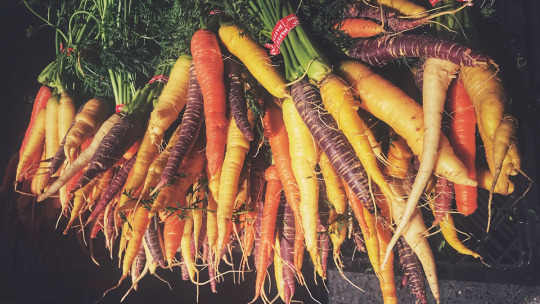
I have most recently started to meal prep, with making a lot of foods and putting them in the freezer. This ended up allowing me to buy the foods in bulk from the local market. And, well... This allowed me to eat some of the foods that the supermarket does not have.
We do have a bit of a problem. And that problem mostly is that we got our food kinda messed up. Because people have lost the connection to the food they eat. But also because of colonialism.
The big thing that happened is, that we lost contact with most local foods. No matter where I go in the "first world nations"... The foods offered to me in the supermarkets are the same - and they also look the same.
This means that a lot of people have no real idea, what foods came from where in the world - but also do not know half of the foods that originated with where they are from, because they are not easily available.

Tomatoes are an example. Not only did historical tomatoes look and taste very differently from the tomatoes we eat today, but obviously... they came from the Americas. So they are not a food that originated with Europe and was not widely available in Europe until the 1600s. While, yes, the first tomates came here more than a hundred years earlier... it took a while for them to catch on.

This is parsnip. Another root vegetable that was commonly eaten in Europe for most of history. It has a more intensive taste than the usual carrot - but is also not that different from it, when it comes to consistency and how it is going to cook.

This is fennel. You might know fennel seeds as a spice or something you might drink as a tea. But the rest of the plant is edible, too, and a surprisingly strong flavored vegetable. It also is very crunchy and makes a really great addition to salads. But it is often not really sold in many places.
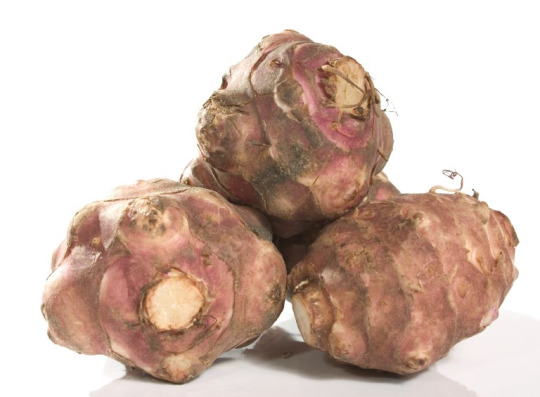
This is the Jerusalem Artichoke, another vegetable that originates within the Americas. To be exact, this is the root of a kind of sunflower. It got its name for being very similar in taste and tecture to the Artichoke. I honestly do not know, though, why it is called "Jerusalem Artichoke", because it does not have anything to do with Jerusalem.
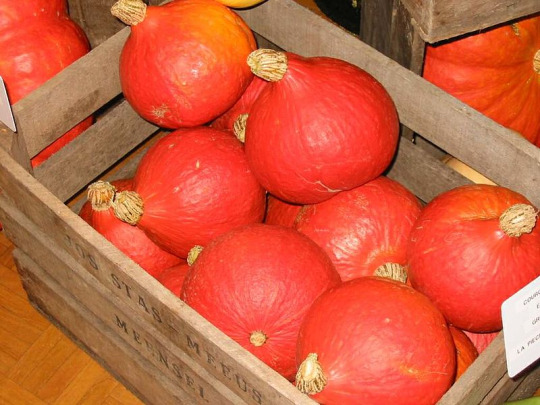
The Potimarron is a kind of squash that - like basically all other forms of squash - originates in the Americas as well. It has a very nutty flavor. In Europe it was very popular in France for a long while, hence the french name. It has tons of meat and really makes for great stews!
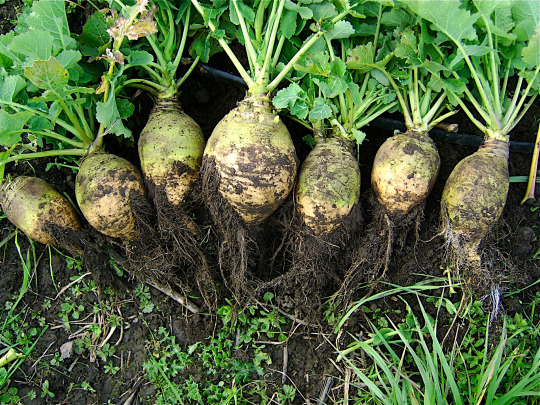
This is a rutabaga, which originates from somewhere in northern Europe. We do not really know from where. All we know is, that it was a Swedish botanist who cultivates the form we still eat to this day in the 1620s. Which is why it is also called the "Swedish turnip". It does taste like a more bitter carrot, but makes really good addition to stews or can be served stamped.
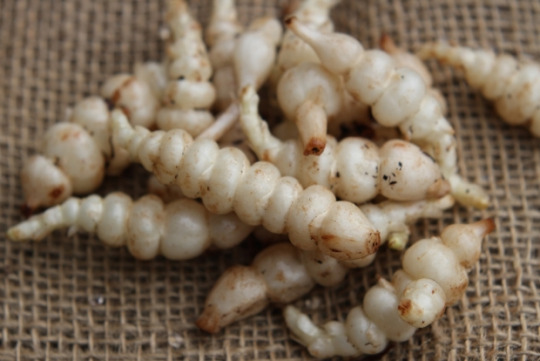
This is the Chinese Artichoke and another root vegetable, that as the name suggest originates from China. It was cultivates in China in the late medieval period and has later made its way to Europe, especially France. It has a really sweet and nutty taste and can be eaten raw or in salads. Though there are dishes mashing the vegetable, too.
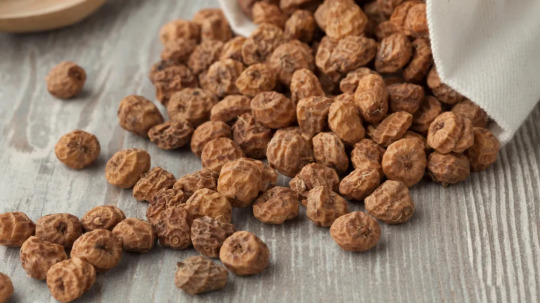
These are tigernuts, a vegetable that has been around forever. It originates in southern Europe, southern Asia and northern Africa. It is a dried fruit, with a sweet and earthy taste and it is known a lot in Spanish cuisine, but also in the cuisine of southern Asia.

Yacon is a root vegetable that originates with Peru, where it is still eaten, while the rest of the world mostly forgot about it. Well, except Japan, where it is currently getting more and more popular. It is a vegetable, but it has a very fruity taste.
I could now go on and name more vegetables from all around the world that were once grown and fed people, but got forgotten more and more in favor of the very limited diet made up of potatoes, corn, potatoes, peppers, cucumber, onion and tomatoes, that is basically what you will get to eat in most places.
And... Well, the thing about it is that... It is not really a good thing that we grow the same stuff everywhere. It is not good for us and it is not good for the environment. It is not good for those foods, either.
I really wish people would try and eat more of the stuff that originates with their region. And that they would eat the not-so-perfect looking foods as well. Because it is gonna be more sustainable in the end.
#solarpunk#food#vegetables#fruits#farming#agriculture#history#food history#sustainable living#sustainability#colonialism
345 notes
·
View notes
Text
Reviving Indigenous Mixtec Cocoa Traditions.
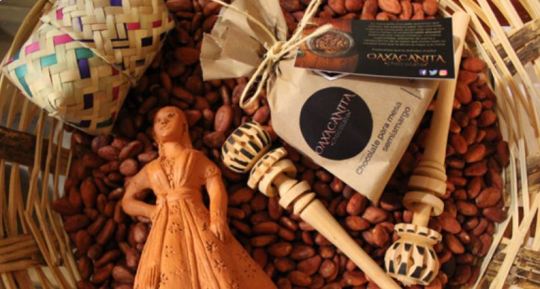
The social enterprise Oaxacanita Chocolate embraces Mexicoʼs rich cocoa culture and is working with Indigenous communities to revive these traditions while spurring the social, economic and environmental development in the state of Oaxaca. Founder German Santillán is building a business that embraces the principles of fair trade and environmental sustainability in collaboration with local communities. “I teamed up with local Indigenous families in Oaxaca, and we began operations in an empty room in my grandmotherʼs house. We started cultivating 20 cacao trees and now we have 5,000 under cultivation in five towns across the region,” he says. Today, Oaxacanita Chocolate is the first proudly Indigenous chocolate company in Mexico to form international alliances with organizations such as the Inter-American Foundation and the US Government.

Intellectual property has played a significant role in brand development. “The first thing we did in Oaxacanita Chocolate – Oaxacanita means, ʻthe little girl of Oaxacaʼ in Zapotec-Spanish – was to register the name of our brand. Then we opened our Facebook page where most of our marketing operations take place. Thatʼs where we make 80% of our total sales,” Santillán explains. Looking to the future, Oaxacanita Chocolate plans to promote its brand and increase its value in multiple markets beyond Mexico. By 2022, the company had sold over 2,000 kilos of chocolate and was expanding its online presence to Canada and the United States.
Reviving Indigenous Cocoa Traditions
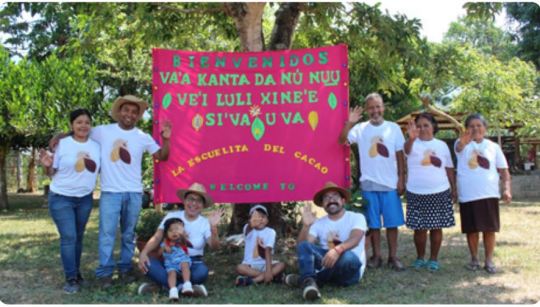
In rural areas of Mexicoʼs Mixtec region, the educational program La Escuelita del Cacao teaches children from Indigenous communities the importance of adopting sustainable agricultural practices. (Photo: Courtesy of Oaxacanita Chocolate)

#Indigenous Cocoa Traditions#sustainable agricultural#agri-food practices#Indigenous communities#worldipday#26 april#world i.p. day#Intellectual property#brand#brand development#Oaxacanita#chocolate#food sector#ip and the sdgs#iP at work
0 notes
Text
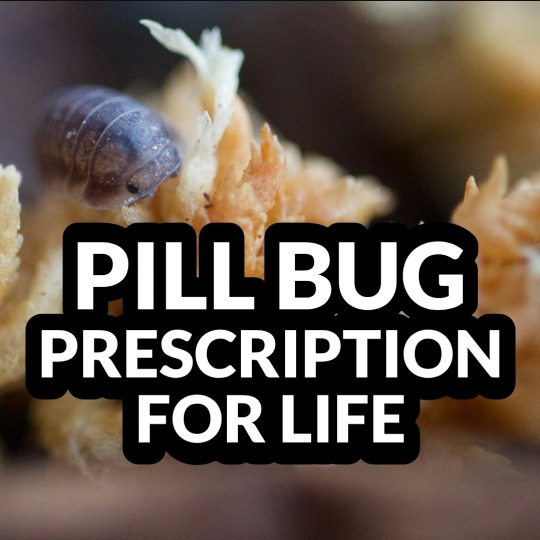
Isopods, aka roly-polies or pill bugs, - tiny crustaceans with BIG impacts
They’re detritivores, meaning they feast on dead and decaying organic matter—like fallen leaves, wood, and even fungi. 🍂🥀🪵
Here’s why they’re vital for our soil:
🌱 Nutrient Recycling: As they munch through plant material, they break it down into smaller particles, speeding up the decomposition process. This enriches the soil with vital nutrients that plants need to thrive.
🔄 Carbon Cycling: By decomposing organic material, isopods play a key role in the carbon cycle, helping store carbon in the soil and reducing carbon loss to the atmosphere.
🌍 Soil Aeration: While burrowing and feeding, isopods loosen compacted soil, improving oxygen flow and creating a healthier environment for plant roots and microorganisms.
Found on every continent except Antarctica, isopods thrive in forests, gardens, and even urban environments. 🌟 Wherever there’s organic matter to break down, these hardworking decomposers are on the job!
So next time you see an isopod, give it some love! 🤍 They’re working hard to keep our soil alive and thriving. 🌿
#soil health#soil science#soil#permaculture#isopods#pill bug#roly poly#environmental education#environmental awareness#regenerative farming#regenerative agriculture#agriculture#sustainable living#sustainable farming#sustainability#organic life#organic matter#organic lifestyle#organic farming#organic#vermicompost#composting#compost lifestyle#compost#biodiversity#conservation#ecomindset#bugs#insects#nature lovers
72 notes
·
View notes
Text
"In response to last year’s record-breaking heat due to El Niño and impacts from climate change, Indigenous Zenù farmers in Colombia are trying to revive the cultivation of traditional climate-resilient seeds and agroecology systems.
One traditional farming system combines farming with fishing: locals fish during the rainy season when water levels are high, and farm during the dry season on the fertile soils left by the receding water.
Locals and ecologists say conflicts over land with surrounding plantation owners, cattle ranchers and mines are also worsening the impacts of the climate crisis.
To protect their land, the Zenù reserve, which is today surrounded by monoculture plantations, was in 2005 declared the first Colombian territory free from GMOs.
...
In the Zenù reserve, issues with the weather, climate or soil are spread by word of mouth between farmers, or on La Positiva 103.0, a community agroecology radio station. And what’s been on every farmer’s mind is last year’s record-breaking heat and droughts. Both of these were charged by the twin impacts of climate change and a newly developing El Niño, a naturally occurring warmer period that last occurred here in 2016, say climate scientists.
Experts from Colombia’s Institute of Hydrology, Meteorology and Environmental Studies say the impacts of El Niño will be felt in Colombia until April 2024, adding to farmers’ concerns. Other scientists forecast June to August may be even hotter than 2023, and the next five years could be the hottest on record. On Jan. 24, President Gustavo Petro said he will declare wildfires a natural disaster, following an increase in forest fires that scientists attribute to the effects of El Niño.
In the face of these changes, Zenù farmers are trying to revive traditional agricultural practices like ancestral seed conservation and a unique agroecology system.
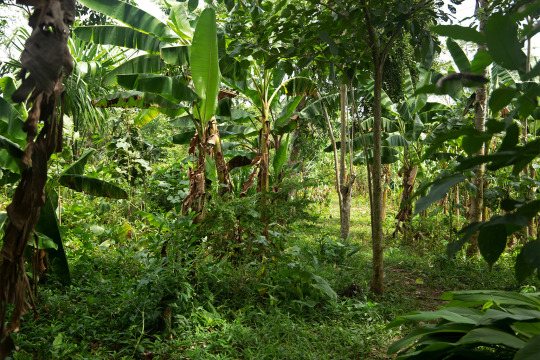
Pictured: Remberto Gil’s house is surrounded by an agroforestry system where turkeys and other animals graze under fruit trees such as maracuyá (Passiflora edulis), papaya (Carica papaya) and banana (Musa acuminata colla). Medicinal herbs like toronjil (Melissa officinalis) and tres bolas (Leonotis nepetifolia), and bushes like ají (Capsicum baccatum), yam and frijol diablito (beans) are part of the undergrowth. Image by Monica Pelliccia for Mongabay.
“Climate change is scary due to the possibility of food scarcity,” says Rodrigo Hernandez, a local authority with the Santa Isabel community. “Our ancestral seeds offer a solution as more resistant to climate change.”
Based on their experience, farmers say their ancestral seed varieties are more resistant to high temperatures compared to the imported varieties and cultivars they currently use. These ancestral varieties have adapted to the region’s ecosystem and require less water, they tell Mongabay. According to a report by local organization Grupo Semillas and development foundation SWISSAID, indigenous corn varieties like blaquito are more resistant to the heat, cariaco tolerates drought easily, and negrito is very resistant to high temperatures.
The Zenù diet still incorporates the traditional diversity of seeds, plant varieties and animals they consume, though they too are threatened by climate change: from fish recipes made from bocachico (Prochilodus magdalenae), and reptiles like the babilla or spectacled caiman (Caiman crocodilus), to different corn varieties to prepare arepas (cornmeal cakes), liquor, cheeses and soups.
“The most important challenge we have now is to save ancient species and involve new generations in ancestral practice,” says Sonia Rocha Marquez, a professor of social sciences at Sinù University in the city of Montería.
...[Despite] land scarcity, Negrete says communities are developing important projects to protect their traditional food systems. Farmers and seed custodians, like Gil, are working with the Association of Organic Agriculture and Livestock Producers (ASPROAL) and their Communitarian Seed House (Casa Comunitaria de Semillas Criollas y Nativas)...
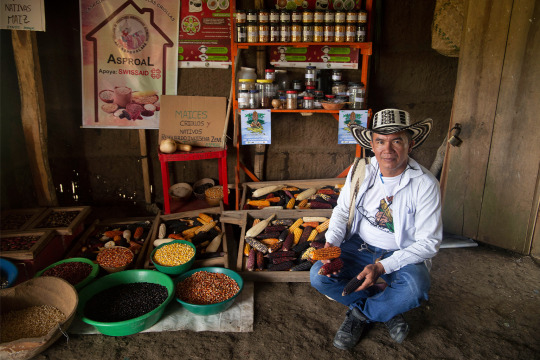
Pictured: Remberto Gil is a seed guardian and farmer who works at the Communitarian Seed House, where the ASPROL association stores 32 seeds of rare or almost extinct species. Image by Monica Pelliccia for Mongabay.
Located near Gil’s house, the seed bank hosts a rainbow of 12 corn varieties, from glistening black to blue to light pink to purple and even white. There are also jars of seeds for local varieties of beans, eggplants, pumpkins and aromatic herbs, some stored in refrigerators. All are ancient varieties shared between local families.
Outside the seed bank is a terrace where chickens and turkeys graze under an agroforestry system for farmers to emulate: local varieties of passion fruit, papaya and banana trees grow above bushes of ají peppers and beans. Traditional medicinal herbs like toronjil or lemon balm (Melissa officinalis) form part of the undergrowth.
Today, 25 families are involved in sharing, storing and commercializing the seeds of 32 rare or almost-extinct varieties.
“When I was a kid, my father brought me to the farm to participate in recovering the land,” says Nilvadys Arrieta, 56, a farmer member of ASPROAL. “Now, I still act with the same collective thinking that moves what we are doing.”
“Working together helps us to save, share more seeds, and sell at fair price [while] avoiding intermediaries and increasing families’ incomes,” Gil says. “Last year, we sold 8 million seeds to organic restaurants in Bogotà and Medellín.”
So far, the 80% of the farmers families living in the Zenù reserve participate in both the agroecology and seed revival projects, he adds."
-via Mongabay, February 6, 2024
#indigenous#ecology#agroforestry#agriculture#traditional food systems#traditional medicine#sustainable agriculture#zenu#indigenous peoples#farming#colombia#indigenous land#traditional knowledge#seeds#corn#sustainability#botany#plant biology#good news#hope#climate action#climate change#climate resilience#agroecology#food sovereignty
1K notes
·
View notes
Text
Strategies deployed for the restoration of degraded land have had promising results in Brazil's semi-arid region, improving the microbial properties of the soil and contributing to a return of native ecosystem services. The techniques include removal of cattle or restriction of their access to specific areas of pasture; cultivation of cover crops; and terracing to control erosion. Recovery of soil microbial properties maintains biodiversity and raises crop yields, contributing to agricultural sustainability. These are the main findings of a study reported in the Journal of Environmental Management by a Brazilian research group comprising scientists affiliated with the University of São Paulo (USP), the Federal University of Piauí (UFPI), the Federal University of Ceará (UFC), and the Federal University of the Agreste of Pernambuco (UFAPE). The review article encompasses 18 studies conducted in the semi-arid region, especially the Caatinga, a local biome consisting mainly of deciduous thorn forest.
Continue Reading.
108 notes
·
View notes
Text
Scientists in Switzerland have invented a way to make chocolate healthier and more sustainable.
Typically, only cocoa beans and pulp are extracted for our chocolate bars. But researchers at the ETH Zurich federal technology institute have discovered that the cocoa pod husk can be used
Their new recipe involves taking what’s known as the endocarp, the inner layer of the fruit shell, and mixing it with some of the pulp surrounding the beans to make a sweet cocoa jelly.
“This means that farmers can not only sell the beans, but also dry out the juice from the pulp and the endocarp, grind it into powder and sell that as well,” explains Kim Mishra, lead author of the study published in the journal Nature Food.
#chocolate#cocoa plants#chocolate industry#science#switzerland#sustainability#good news#environmentalism#food#farming#agriculture#sustainable farming#environment
55 notes
·
View notes
Text
My least favourite thing that this generation is doing, is saying that it is only the corporations fault for our failing world.
It is their fault, don't get me wrong. But we as individuals are just as responsible for our own emissions and waste.
You can do stuff to help, do not blame the corporations, companies and businesses and then turn around and do nothing about it.
Campaign against them, ask for change, get laws and regulations introduced, don't do nothing while pumping out your own emissions/waste and putting the blame solely on the corporations shoulders.
"Its one 'no' vote" said 9,452,792 people (AU)
"Its one straw" said 500,000,000 people every day (US) "Its only one plastic bag" said every American for 365 days (totalling around 365 bags per person per year)
#enviroment#environmentalism#enviromental#climate justice#climate change#climate crisis#climate action#climate emergency#sustainability#climate catastrophe#environmentallyfriendly#agriculture#environment#ecofriendly
70 notes
·
View notes